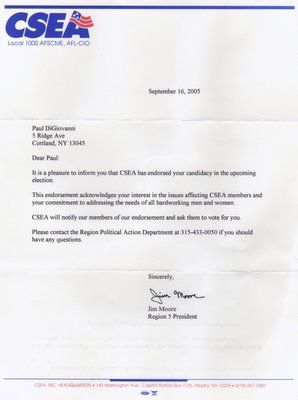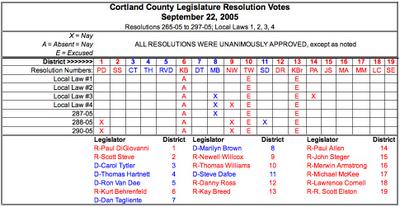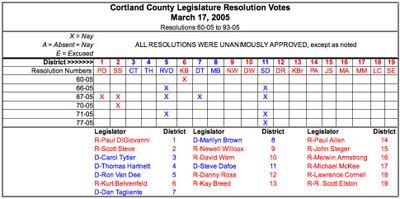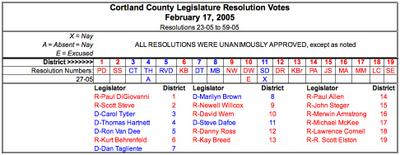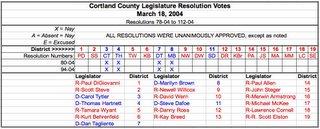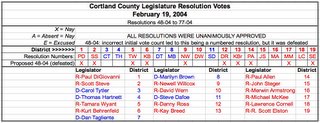Letter to First Ward Citizens
Dear Fellow Citizen of the First Ward:
I write to you as I begin my campaign for reelection to the County Legislature. First, I want to thank you for having given me the chance to represent you. I hope that as you read this letter, you will come to agree that we have made a lot of progress these past two years. There is a lot of good news to report, so this letter is long, but I respectfully ask you to please take the time to continue reading. As I will be making door-to-door visits over the next few weeks, we can talk about these (and other) things when we meet.
Allow me to start with a bit of history. The newly elected Legislature arrived in office on January 1, 2004, with a budget prepared by the prior legislature that called for $71 million in spending. You might recall that I wrote an essay in 2001 (during my first run for office) arguing that we were not taxed too little, but that we spent too much. I am proud to have been a key member of a legislature which, though allowed to spend up to $71 million of your money, spent only $62.7 million. We ran a one-year surplus of $4.8 million. That money has been added to the fund balance - think of that as the county's piggy bank - which is now a healthy $8.9 million. To prove that this is "no shell game" (to quote our independent outside auditor, Rick McNeilly), we are doing it again: we are projecting a surplus this year of about $3-4 million, which could take our savings account to $12-13 million.
Again quoting our outside auditor, this is because operations are "much, much improved". It is, he said, the direct result of controlling spending. When I ran before, the prior legislature blamed the county's financial crisis on "unfunded mandates" and Medicaid - not ever their own excessive spending. You haven't heard the current legislature complain about unfunded mandates and Medicaid much, because we were right: although these are costly (and we have addressed them as best we can), they were not the reason our finances were so sickly: runaway spending was. You gave us the chance to prove we were right, and I believe we have: we have controlled spending and delivered a budget surplus.
How did we do this? We said "no" when we had to. And when the backlash came from the people who didn't like being told "no", we stood firm. The Treasurer's Office was a mess: the annual report (the "AUD") was late year after year; the State Comptroller's Office found major problems not just in that Office, but in the prior legislature's lack of oversight; and everything from the computer software to the lack of staffing was blamed. By prioritizing duties within the Treasurer's Office - and without adding staff - the AUD was completed in a timely manner. This allowed the outside auditor to complete his report much earlier than he had been able to in recent years. This keeps us on track to present the 2006 budget to the taxpayers in October – not hiding it until after the election. We have also said no to a lot of bad ideas that had become "standard operating procedure", demanding justification for spending YOUR money. If they can't, or won't, give us some very good reasons for spending your tax dollars, we say “no”.
But here's the thing that you don't often hear: we also said “YES!”. Let's go back to the Treasurer's Office for a moment. We said “YES!” to establishing an Audit Committee (which I chair) so that we keep an eye not just on the Treasurer's Office, but on the whole audit process. We said “YES!” to moving accounting of Fixed Assets (that is, inventory) to the Administrator's office. For the first time in years, we have taken inventory and we can account for our "fixed assets" (which is necessary by current governmental accounting standards). We said “YES!” to moving payroll to the Personnel Office, so that the Treasurer's Office can focus on the AUD. We said “YES!” to expanded training in all departments, including the Treasurer's Office, sending county personnel to classes at Onondaga Community College and giving them more computer training. We are getting monthly reports from the Treasurer for the first time in years.
Our success, though, is about much more than the Treasurer's Office. We also said “YES!” to adding a Sheriff's Deputy to the Fraud Investigation Unit in Social Services, saving many more dollars than it costs to pay for this position. We had 15 arrests for fraud last year, when we hadn't had more than 1 or 2 in any previous year in memory. We said “YES!” to a new health insurance policy that has saved you as taxpayers millions of dollars. We said “YES!” when Hospice needed an additional nurse, because it is much better run than the average program in New York state or surrounding counties. We said “YES!” to department managers who could give us good reasons to spend tax dollars, and who took the challenge to work with each other across departments to ensure efficient delivery of services. We will continue to say "YES!", to best practices and good government - to things which benefit you as citizens and taxpayers.
Many of us have played a key role in establishing this winning record, and I want you to know about mine. I am Chairman of the Health Committee, Vice-Chairman of the Budget & Finance Committee, and a member of the Human Services Committee. I chaired the Audit & Performance Assessment Team, a bipartisan committee which did the hard work of fixing the problems in the Treasurer's Office - and the poor oversight of that department by the prior legislature. I am Chairman of the Audit Committee and I am the Majority Leader, second in command after the Chairman. I have played a role in encouraging competition for pre-school programs offered to our young children, so that we can offer the same services locally that we are now paying a lot more to get in other counties (not to mention the long bus rides our kids have to endure). A new autism program at The Franziska Racker Center will save us up to $30,000 annually for each local child enrolled. I have encouraged cooperation with local organizations, such as Cortland Memorial Hospital, to deliver services (for example, speech language pathology) better than if we did it alone. I have fostered cooperation among departments, particularly Human Services and Health, so that local folks who receive county services will get them more efficiently and appropriately. On Budget & Finance, I have taken a lead role in critical review of any proposal to spend your money - whoever wants to spend it must give me a good reason to support it. If I don't approve of a spending request, I explain why to the person proposing it and to fellow legislators.
Do you recall the consequences to you of the loose spending of the prior legislature? In 2001, in order to balance the budget without raising taxes too much, they raided the piggy bank - withdrawing over $3.5 million. As I said when I ran in 2001, that works once, but what happens next? Spending was increased to a level that required about $19 million in property taxes – but the tax levy at the time was around $14.7 million. Simple math said that our property tax rate would have to go up by nearly 30%. When I said so, I was called "Chicken Little" by my opponents, but the math was proven right! Can you afford to risk having the legislature go back to the old way of doing things? Can you afford to risk emptying the piggy bank which we have worked so hard to refill? If that happens, you will again have to pay for it. Remember, the prior legislature planned to spend $71 million in 2004, but, with your support, a new legislature took over and spent only $62.7 million - nearly 12% less! This new legislature refused to raise the constitutional tax limit. We successfully lobbied Albany to cap the local share of Medicaid. We exercised needed fiscal discipline. The tax rate increase that we gave you in our first budget was just 2.9% (the non-Medicaid increase was only 0.9%), the lowest in years, and it wasn't kept low by stealing from the piggy bank! On the contrary: we filled the piggy bank! We will work to keep taxes low again this year. I have repeatedly challenged the Administrator to have the budget ready by the middle of October, and he has assured me that he will. I will hold him to his promise so that you will know the tax rate before you go to the polls in November.
Don't believe for a minute that this was just dumb luck - that we look good just because we have been fortunate enough to be in office when all these good things "just happened". Our success has taken hard work, researching issues, showing up for lots and lots of meetings, taking a stand against the "business as usual" culture, and standing firm when opponents criticized us again and again. It has taken determination and vision. So this is my plea to you: Know my record. Recognize my success. Understand my role helping to make this happen.
To continue this record of success will require your vote. If you endorse my record by giving me your vote, it will be my pleasure to represent you again for the next two years.
Sincerely,
Paul DiGiovanni
Cortland County First Ward Legislator
PS: A letter, even one this long, can't address everything. If there are matters that you would like to discuss, please call me (756-6313), send e-mail (electdoc@twcny.rr.com), or if you are home when I visit, we can talk face-to-face. There is even more good news, so I look forward to chatting with you soon.
